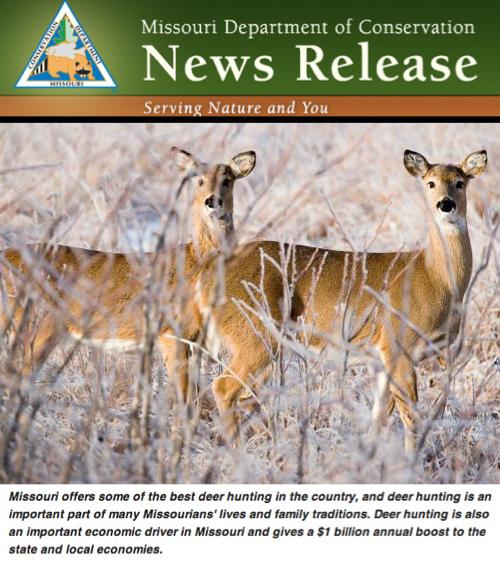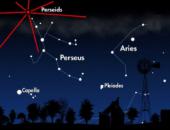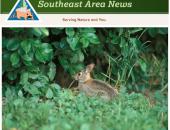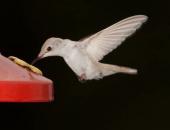Local News
New Changes for 2016-2017 Deer Regulations
August 20th 2015 by Dee Loflin

JEFFERSON CITY, Mo. – The Missouri Conservation Commission set season dates and limits for the 2016-2017 fall deer season and gave initial approval to several deer-hunting regulation changes proposed by the Missouri Department of Conservation (MDC) at the Commission’s Aug. 19 meeting in Jefferson City.
Approved changes to fall deer season structure for 2016-2017 include:
Maintain current timing of the November portion and reduce the length from 11 to 9 days.
Expand the late youth portion to three days beginning the first Friday after Thanksgiving.
Reduce the length of the antlerless portion from 12 to 3 days and begin on the first Friday in December.
Eliminate the urban zones portion.
Proposed regulation changes to fall deer season structure for 2016-2017 include:
Allow crossbows as a legal method during the archery deer and turkey seasons.
Allow the use of crossbows during the fall firearms turkey season.
Reduce the limit of antlered deer from 3 to 2 during the combined archery and firearms deer hunting season, with no more than one antlered deer taken during the firearms deer hunting season.
Remove the hunting method exemption requirement related to crossbows.
Missouri’s rule-making process includes a 30-day public comment period. Comments related to the proposed regulation changes can be submitted online to the Conservation Department from Oct. 2-31 at mdc.mo.gov/node/24141. Full verbiage of the proposed amendments will be posted on the webpage after Sept. 15.
The Commission will make its final decision on these proposed changes at its December meeting. With final approval, the regulation changes would become effective in March 2016 and implemented for the 2016-2017 deer hunting seasons.
The Department is also working to simplify conservation area deer-hunting regulations by limiting methods and use of firearms and archery antlerless permits. To see the list of conservation areas with proposed changes to hunting methods and to provide comments, visit the MDC website at mdc.mo.gov/node/18891 from Sept. 1 to Nov. 30. The webpage will not be available until Sept. 1.
The Department will also continue to gather input from citizens on a variety of deer hunting-related topics, including nonresident permits and prices, through public surveys and its website in early 2016.
When formulating recommendations for these regulation changes, the Conservation Department used deer hunter surveys, landowner surveys, archery-hunter observation surveys, deer population simulations, biological data, harvest summaries, and public input gathered from 22 public open houses held around the state and about 11,800 public comments received at the public meetings and online.
“The goal of the Conservation Department’s deer management program is to use science-based wildlife management combined with public input to maintain deer population levels throughout the state that provide quality recreational opportunities while minimizing human-deer conflicts,” said MDC Deer Biologist Jason Sumners. “As deer populations in Missouri have changed over the last 75 years, so have our management strategies. In modifying the hunting season structure, our aim is to achieve a deer population that is biologically and socially acceptable while also promoting hunter participation, recruitment, and retention.”
Missouri offers some of the best deer hunting in the country, and deer hunting is an important part of many Missourians' lives and family traditions. Deer hunting is also an important economic driver in Missouri and gives a $1 billion annual boost to the state and local economies.
2016-2017 DEER HUNTING SEASON DATES
Archery Season
Sept. 15 - Nov. 11, 2016, and
Nov. 21, 2016 - Jan. 15, 2017
Firearms Season
Early Youth Portion: Oct. 29 - 30, 2016
November Portion: Nov. 12 - 20, 2016
Late Youth Portion: Nov. 25 - 27, 2016
Antlerless Portion: Dec. 2 - 4, 2016
Alternative Methods Portion: Dec. 24, 2016 - Jan. 3, 2017
REASONS FOR REGULATION CHANGES
REDUCING NOVEMBER PORTION LENGTH
Regarding maintaining the current timing of the November portion and reducing the length to nine days, MDC Deer Biologist Jason Sumners explained that over the last two decades deer hunter numbers and deer harvest opportunities have increased substantially while the deer population has stabilized or been reduced in many parts of Missouri so additional harvest opportunities are no longer necessary to meet desired deer population goals.
“The final two days of the November portion of the firearms deer season have traditionally been the two days with the lowest hunter harvest and number of hunting trips,” said Sumners. “Reducing the November portion by two days will not result in a dramatic decrease in harvest or hunting opportunities. This one regulatory component, when combined with other changes, will help to stabilize and increase deer populations in some areas.”
EXPANDING LATE YOUTH SEASON
Sumners explained that the current late December or early January timing of the late youth portion has resulted in low participation and low success. Expanding the length to three days and adjusting the timing to the weekend after Thanksgiving should increase participation and success as a result of better deer activity and weather conditions in late November compared to the current timing.
“Hunter recruitment and retention is an important component in maintaining Missouri’s hunting heritage and our ability to manage deer populations in the future,” Sumners said.
REDUCING LENGTH OF ANTLERLESS PORTION
Regarding reducing the length of the antlerless portion to three days and beginning on the first Friday in December, Sumners explained that the deer population in most of Missouri is currently at or below population goals so the additional antlerless-harvest opportunities are no longer necessary to meet desired deer population goals.
“Shortening the antlerless portion is a compromise to maintain some additional hunting opportunities and allow for additional antlerless harvest where necessary,” Sumners said. “The increase in the number of deer hunting days over the last two decades as a result of the creation of early and late youth portions, and the expansion of November, antlerless, and alternative methods portions has created conflicts between deer hunters and other outdoor users such as small game hunters. Therefore, the reduction is a compromise that is acceptable to most firearms deer hunters and will reduce conflicts that occur between deer hunters and other outdoor users due to the length of the current deer hunting seasons.”
ELIMINATING URBAN ZONES
Sumners explained that eliminating the urban zones portion will simplify the deer season structure and will not jeopardize progress towards effective urban deer management that has occurred in many communities across the state.
“The urban zones portion was implemented as one tool to address issues associated with overabundant urban deer populations,” Sumners said. “However, additional firearms hunting opportunities in urban zones do little to manage deer populations where the ability to use firearms is limited. The majority of harvest during the urban zones portion occurs in the most rural areas and does not ensure adequate deer harvest in the locations where urban deer conflicts occur.”
ALLOWING CROSSBOWS DURING ARCHERY SEASON
Sumners explained that allowing crossbows as a legal method during the archery deer and turkey season will provide additional opportunities for young hunters and prolong participation for older hunters while not significantly increasing the harvest.
“Physical limitations of young hunters delay their entry into archery hunting and physical limitations of older archery hunters result in their declining participation,” Sumners said. “Our challenge is to balance contrasting hunter opinions with the desire to provide maximum hunting opportunities while also responsibly managing Missouri’s deer population. We have received an increasing number of requests to expand the archery season to include crossbows. We expect that the inclusion of crossbows will increase the harvest during the archery season, but do not expect it to result in a significant increase in total deer harvest.”
ALLOWING CROSSBOWS DURING FALL TURKEY FIREARMS
Sumners explained that allowing the use of crossbows during the fall firearms turkey season would be consistent with method allowances for other firearms hunting seasons and spring turkey season.
“The Department has tended to allow all lesser hunting methods during firearms hunting seasons so it is natural to allow crossbows during the fall firearms turkey season,” Sumners said.
REDUCING ANTLERED DEER LIMIT
Sumners explained that reducing the antlered deer limit stems from an increasing desire of hunters to see more bucks in older age classes.
“We considered a number of regulation changes, including pushing back the opening of the November portion of the firearms season and limiting hunters to one buck during the combined archery and firearms hunting season,” Sumners said. “However, results from our archery and firearms hunter surveys showed little support for those changes. Therefore, reducing the limit for antlered deer from three to two during the combined archery and firearms deer hunting season, with no more than one antlered deer taken during the firearms deer hunting season, is supported by many hunters, and a step in the right direction.”
REMOVING HUNTING METHOD EXEMPTION RELATED TO CROSSBOWS
Sumners explained that allowing crossbows during archery seasons will make the crossbow medical exemption no longer necessary.
SIMPLIFYING AREA REGULATIONS
Sumners explained that simplifying various conservation area regulations by limiting methods and use of firearms and archery antlerless permits would both increase hunter satisfaction and give area managers the ability to adjust regulations to adapt to current deer population conditions.
“We continue to strive to manage deer numbers at desirable levels while providing diverse deer hunting opportunities for the public,” Sumners said. “The current set of deer hunting options on conservation areas can be confusing and do not allow managers to adapt regulations to changing deer populations. As a result, deer hunters on public land generally have lower success rates, perceive lower deer numbers, and tend to rate their hunting experiences lower than hunters on private land.”
Last Updated on August 20th 2015 by Dee Loflin
https://showmetimes.com/Blogpost/uuk3/New-Changes-for-20162017-Deer-Regulations





